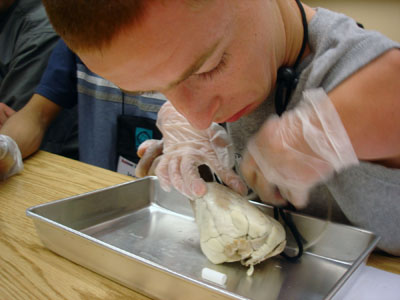Practitioner Discussions

Participant suggestions that emerged in CBI discussions include those listed below.
What are some specific things we can do this school year to support and encourage STEM students with disabilities?
CBI participants suggested the following:
- Have AccessSTEM continue to share information about outreach opportunities to department chairs in STEM disciplines;
- Send AccessSTEM staff to meetings of graduate and undergraduate advisors to distribute materials and answer questions. Especially consider pre-engineering advisors. Seek out advising online distribution lists and newsletters;
- Engage with tutoring programs and study centers (e.g., the University of Washington's Engineering Study Centers);
- Offer to provide technical support for linking STEM department websites to the AccessSTEM website;
- Attend meetings of lab managers to offer guidance about universal design of computer and science labs;
- Inform faculty with existing NSF grants about Research Experiences for Undergraduates (REU) funds that can be used to hire students with disabilities;
- Attend trainings for new teacher assistants in STEM departments;
- Work at the dean level to encourage supportive and inclusive language on course syllabi and websites;
- Work with advisors to teach them how to encourage appropriate students to register with disability service offices
- Attend STEM faculty meetings to deliver presentations about project offerings;
- Connect with staff of career centers, transfer centers, and student programs (e.g., TRiO);
- Participate in events for veterans, many of whom have disabilities.
What are some specific things we can do this school year to recruit students with disabilities into STEM programs?
CBI participants suggested the following:
- Target AccessSTEM outreach to department chairs and meetings of graduate and undergraduate advisors;
- Conduct recruitment through specialty/introductory courses, such as UW's open enrollment "Introduction to Nanotechnology" class;
- Host custom workshops during events on campus, highlighting the achievement of students with disabilities and/or inviting them;
- Locate employees who have disabilities and ask them to serve as project mentors and recruiters;
- Engage with professional student societies, such as the American Society of Mechanical Engineers;
- Participate in departmental orientations for newly accepted STEM majors;
- Partner with alumni associations to market AccessSTEM project activities off-campus;
- Invite advisors to activities on campus for STEM students with disabilities so they can see the potential these students have for pursuing STEM;
- Have AccessSTEM staff available for consultations at disability services offices on the first few days of each term;
- Host public panels on campus that include people who are currently in successful STEM careers;
- Create a website for students that includes highlights of student achievements;
- Host information sessions for students with disabilities about jobs in STEM fields.
What are specific ideas for recruiting undeclared freshman and sophomores into STEM majors?
CBI participants suggested the following:
- Conduct recruitment in the dorms and seek out special housing programs (e.g., UW's "Engineering Community" in McCarty Dormitory);
- Send information to resident advisors of such programs;
- Share disability-related projects with the general student body and invite students with disabilities to learn more (e.g., UW's Mobile American Sign Language project);
- Encourage advisor's online tools to have AccessSTEM project information and links to the project website;
- Tap into existing student programs such as Emerging Leaders;
- Participate in all-college orientations for incoming freshmen;
- Invite students with disabilities to STEM faculty presentations and talks.
What are specific ideas for recruiting community college students into STEM programs?
CBI participants suggested the following:
- Invite community college students to the UW campus for weekend events, such as the College of Engineering Open House or AccessSTEM-sponsored labs;
- Send AccessSTEM project staff to annual meetings hosted by the UW Admissions office for advisors of community colleges;
- Partner with transition offices at the community colleges
What are specific ideas for reaching out to high school students?
CBI participants suggested the following:
- Consider working with UW Admissions, through a sanctioned entity such as the Executive Committee of the Dean's Office, to help make admissions outreach more effective and welcoming for students with disabilities;
- Recruit through the Department of Vocational Rehabilitation;
- Work with transition offices of Seattle Public Schools;
- Tap into existing programs such as GEAR UP;
- Send a brief recruitment email to Running Start coordinators at partner colleges, asking them to forward it to Running Start students;
- Send college students with disabilities into the high schools to recruit to the project as well as answer general questions about pursuing college and STEM.